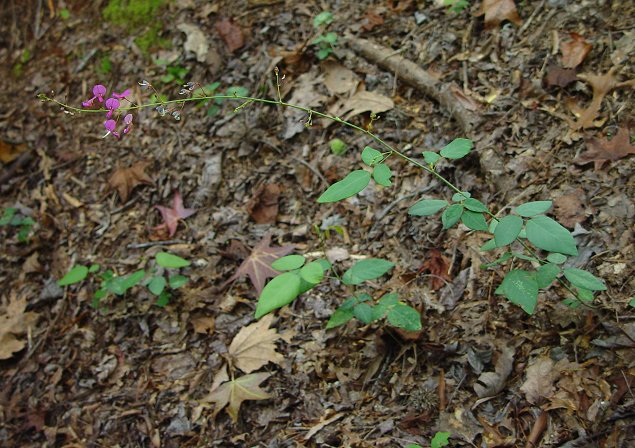Desmodium laevigatum (Nutt.) DC.
Smooth Tick Trefoil

Native
CC = 7
CW = 5
MOC = 25
© DETenaglia
Desmodium laevigatum (Nutt.) DC.Smooth Tick Trefoil | |
 |
Native CC = 7 CW = 5 MOC = 25 |
© DETenaglia |
|
Family - Fabaceae/Faboideae Stems - To +1m tall, erect to reclining, glabrous, glaucous, green with some purplish-red at nodes, single from base and branching in inflorescence.
Leaves - Alternate, trifoliolate, petiolate, stipulate. Petiole to 5.5cm long, glabrous, slightly thickened at base for 5mm or so. Lateral leaflets ovate to oblong, acute to obtuse, entire, glabrous and shiny green above, glaucous and glabrous below or with very few hairs on midrib, to +/-8cm long, +/-3.5cm broad. Petiolules to 5mm long. Stipules at base of petiolules to 2-3mm long, linear-attenuate. Terminal leaflet similar to lateral leaflets but typically larger and on a petiolule to 2.5cm long. Petiolule glabrous.
Inflorescence - Terminal racemes or loose panicles to +40cm long. Axis pubescent. Pedicels to 1.5cm long, pubescent. Flowers 2-3 at each node.
Flowers - Corolla rose-pink, papilionaceous. Standard to 1.2cm long, 8mm broad, with two whitish spots near base. Stamens diadelphous, filaments white. Style green, 3mm long, glabrous. Ovary 5mm long, pubescent, reddish-green. Calyx bilabiate, reddish-purple. Calyx tube to 1.1mm long. Upper lip single lobed, to 2mm long, reflexed in flower. Lower lip 3 lobed. Lobes attenuate, to 3mm long, pubescent.
Flowering - July - September. Habitat - Rocky open woods. Origin - Native to U.S. Other info. - There are about 18 different species of Desmodium in Missouri, most are very difficult to tell apart. This species is a bit easier to tell because it has the shiny green leaves which are glabrous and glaucous below. Also, the flowers of this species are fairly large and showy for the genus. D. laevigatum can be found in the southern 1/3 of the state and prefers to grow in acidic soils on chert, sandstone, or granite. Photographs taken on Garrison Ridge, Mark Twain National Forest, Christian County, MO., 7-28-00 and in Brown Summit, NC., 9-21-02. |